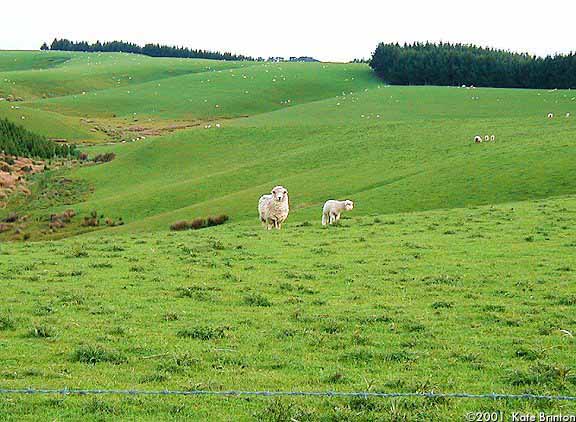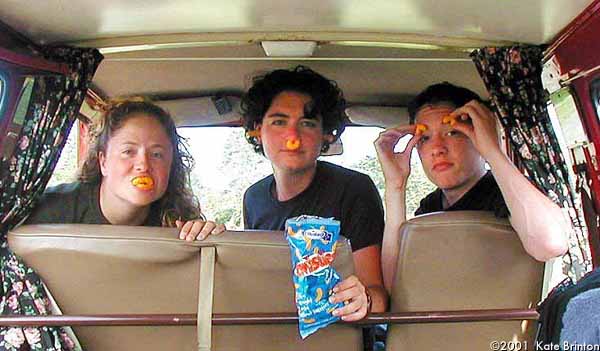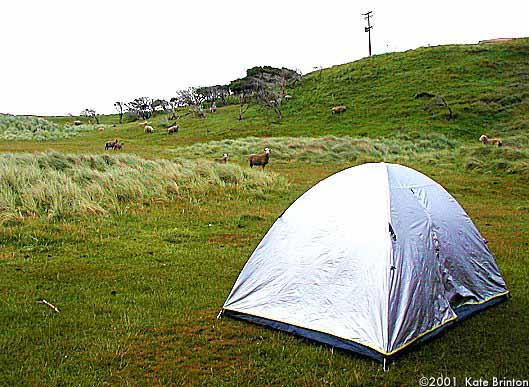[ New Zealand ~ 1, 2, 3, 4, 5, 6, 7, 8, 9, 10, 11, 12, 13, 14, 15 ]
Life in the Ladybug
On a typical day in our South Island road trip, you would find us driving around in the Ladybug. From my pictures, you can see what she looks like, and that she is not very big. As in the States, seatbelts are mandatory in New Zealand, and the Ladybug only has seatbelts in the front. So, despite the comfortable bed in back, the three of us squeeze into the front seat and strap ourselves in.Note 1~22~02: After experiencing several different flavors of Asian driving, I can say that New Zealand drivers are still the most reckless I've ever seen.Immediately after leaving the rental car company, we discovered that the radio sound quality and reception were dubious at best. So, our first stop was to buy a cheap portable radio/tape-player and a tape each. We ran it on batteries for a few days before the idea struck and we got a cigarette lighter adapter for it in an electronics store.
We expanded our tape collection in Wellington at a music store that sells all its used tapes for $5 (they have since lowered it to $4). That's in New Zealand dollars, which equals US$2. We ended up with approximately 30 tapes. You'd be surprised to find out just how quickly one can get tired of 30 tapes. By the end of our trip, our favorite tapes (the ones we all still liked) were:
We played the tapes on a rotational basis - each of us choosing the next tape in turn. This eliminated time-wasting discussion, but made me have to suffer through Matt's Bon Jovi and Limp Bizkit and Farley's Prince (old disco phase). On the up side, I was able to listen to my Midnight Oil album ("20,000 Watt RSL").
"Play" - Moby
"The Fat of the Land" - Prodigy
"Vegas" - Crystal Method

Sheep always dotted the hillsBack to the typical day. We'd be driving along, listening to a tape. The landscape would be covered, as usual, with sheep. It wouldn't be unusual for us to be eating Twisties, which are a much tastier version of puffy Cheetos that are quite addictive. We ate about a bag a day in a ritualistic orgy of face-stuffing.

We were really TwistedIn the back of the Ladybug, we had a box of groceries, a big water tank, and a cooler with milk, cheese, etc. We tried to eat that food as much as possible, since it was much cheaper than eating out. Generally, we only ate out in bigger cities where the more varied cuisine was too tempting.
Most days, at the end of the day, we would find ourselves driving around in the dark, searching intently for a place to park our van and camp. Despite our first night's experience (a busy, truck-laden road), we found most roads on the South Island to be fairly deserted, even in the daytime. If we pulled off the main highways, sleeping by the road was quite a tenable option.
Once an acceptable spot was found (in the dark, we couldn't be too picky), we parked the van. One of us would set up the van's awning and begin to cook dinner, while the other two set up the tent. We became quite good at this, and by the end could set up the tent in less than a minute.

Our tent, and some sheep who joined us in the early morningWe alternated who would sleep where. Farley and Matt were one unit, and I was another. So, one night I would sleep in the tent, and Farley and Matt would sleep in the van. The next night it would be the opposite. They enjoyed the intimacy of being close, and I enjoyed the extra space of sleeping alone.
Our van had a gas stove with two burners and a grill, and it was quite easy to whip up a nice meal. We unlatched the cupboard, the door of which folded down to become a table, and usually all sat inside to avoid bugs.
I got quite used to the camping life. It became second nature for me to find a secluded spot and yank down my pants to urinate standing up. I learned a new appreciation for simple things like being warm and dry. The awesome power of the sun became clear to me after it soothed away the damp from a rainy night. We were fortunate that we never had two rainy days in a row, which gave us time to dry out in between.
Every third day or so, we stayed in a holiday park, which, for about NZ$9 (US$3.60) each, provided us with shower, bathroom, laundry, kitchen, and TV facilities. We found that the holiday parks varied widely in the quality of facilities, protection from noisy roads, and what was included (and what costed extra). Most of the time, though, we found them adequate.
In the morning, we would wake up to an alarm (my watch) if we had something planned, or wake up at a more leisurely pace. After breakfast, we would break down the tent, and load all of our bags back into the back of the Ladybug (the bags spent the night either in the tent or in the front seat to make room for sleeping).
Then, we would head out to our next destination.
The Faster You Go, The Bigger The Mess
New Zealand, in general, has good signs. Everything is clearly and informatively marked. In addition to mileage signs and pointers to places, there are also a large number of intimidating, large signs designed to convince people to drive slowly and soberly.
"The faster you go, the bigger the mess" was my favorite sign. Others included "DRINK and DrIvE" and "You're a long time dead, so what's the hurry?"
These are because New Zealanders drive very fast, and often pass dangerously. We, however, didn't need signs to remind us to drive slowly. The Ladybug was barely able to make it up hills, let alone speed. We kept to the speed limit or below the whole trip, often pulling over to let the faster vehicles by (including semi trucks and other campervans).
Matt drove the Ladybug at the beginning of the trip; being from Wales, driving on the left was natural for him and he only had to master the Ladybug's temperamental stick shift (which he did with ease). The second morning, Farley bravely decided to give driving a try. Despite a few turn-outs onto the wrong side of the road at the start, she did very well (I was impressed).
I felt bad to not do my share of the driving, but I lacked the confidence that I could think about driving on the left side of the road while also remembering how and when to shift. See, I have never owned a manual-transmission car, and have only driven one a few times.
But as the days went on, I adjusted (as a passenger) to the feeling of driving on the left. We descended the west coast of the South Island, finding the roads more and more desolate, until I knew that we had reached the best possible time for me to get behind the wheel. I steeled myself and volunteered to drive.
Around mid-day, we found a small gravel area to the side of the road that was big enough to drive in circles. I got behind the wheel and tried several times, unsuccessfully, to get the Ladybug moving. Each time, she coughed and died. I was getting frustrated when we realized that it was in third gear, instead of first. Once that was resolved, I got her moving on the first try. After a few circuits in the gravel and some practice shifting, I turned out onto the road.
I described in a previous message how confusing it is at first when everything is backwards. I was used to the general position of cars on the road by now, but what I found difficult this time was getting the van centered properly in my lane. I was sitting on the opposite side of the car and it took a while for me to adjust to be able to easily drive between the lines.
I may not have accurately described how empty parts of the South Island are. We were driving on the major highway down the west coast, but as I began driving, we didn't see another car in either direction for maybe half an hour. It was a comfortable way to begin.
Eventually, my confidence improved and, despite a few wrong turns here and there, I was finally able to drive around downtown Christchurch (among other towns), and navigate roundabouts, with ease.
I'm very proud of myself. Getting all those things (centering, the left side of the road, shifting, etc) working at the same time required some major concentration at first. Not to mention some anxiety! Fortunately, Matt and Farley were very reassuring and coached me through the tough bits.
~ * ~ The roads in the South Island are very empty, and building bridges is expensive. Therefore, almost all bridges down there are one lane. Unless you're in Christchurch or Dunedin, you'll come across these regularly, and they're rather nerve-wracking at first. One direction of traffic has the official right of way, as indicated by a sign before the bridge. I assume this is to resolve a dispute if two vehicles arrive at exactly the same time. In practice, the actual right-of-way is taken by whoever gets there first, since if a vehicle is on the bridge, anyone coming the other direction can't get across until the first vehicle is through.
Those without right-of-way are supposed to stop before entering the bridge, and those coming in the other direction can, presumably, keep on driving. But after a few bridges, you begin to realize that chances are pretty slim that you will meet another vehicle in the other direction, since cars seem to only pass each other every 10-15 minutes. So, vehicles in both directions generally slow down just enough to do a quick glance across the bridge before crossing. This usually works, but occasionally requires some quick stops. We were all rattled by these at first, but they became matter-of-course after a while.
All in all, I'm sure New Zealand is a very relaxing place to drive compared to some other places in the world. All the same, it was a good learning experience for me.
